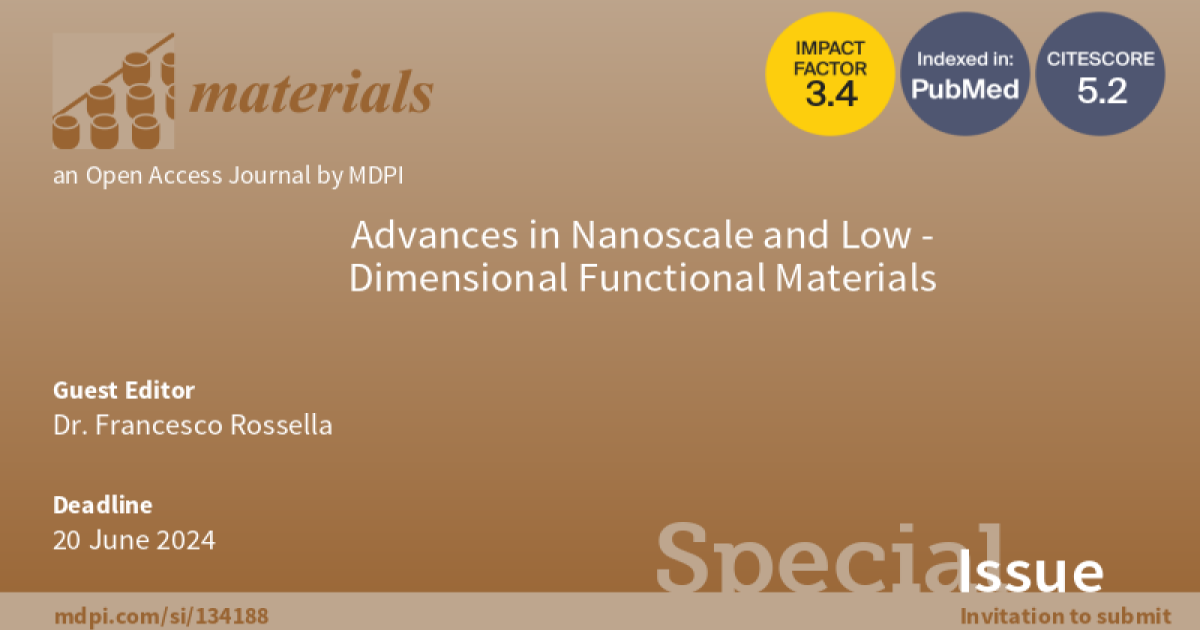Advances in Nanoscale and Low-Dimensional Functional Materials
A special issue of Materials (ISSN 1996-1944). This special issue belongs to the section "Advanced Nanomaterials and Nanotechnology".
Deadline for manuscript submissions: closed (20 June 2024) | Viewed by 10445

Special Issue Editor
Interests: III-V semiconductor nanowires; nanowire devices and applications; transport phenomena at the nanoscale; low dimensional nanomaterials
Special Issues, Collections and Topics in MDPI journals
Special Issue Information
Dear Colleagues,
Quasi-1D systems, e.g., nanowires, novel 2D materials, thin films, and nanoparticles, are playing an emerging role as functional materials in different fields of applications, including energy conversion and harvesting and quantum technologies, as well as biology-oriented fields such as translational nanomedicine and translational nanotechnologies at large.
Nanotechnology is taking on the key challenge of implementing nano- and low-dimensional-materials in nanodevice architectures, disclosing the potentials of such nanoscale systems, and enabling unique functionalities in nanoelectronics, nano-optoelectronics, and photonics.
This Special Issue aims to realize a collection of selected research articles and reviews authored by leading scientists that are shaping the future of functional nanomaterials. In this, the Special Issue will allocate dedicated slots for publishing articles authored by emerging young scientists and by women in science.
Dr. Francesco Rossella
Guest Editor
Manuscript Submission Information
Manuscripts should be submitted online at www.mdpi.com by registering and logging in to this website. Once you are registered, click here to go to the submission form. Manuscripts can be submitted until the deadline. All submissions that pass pre-check are peer-reviewed. Accepted papers will be published continuously in the journal (as soon as accepted) and will be listed together on the special issue website. Research articles, review articles as well as short communications are invited. For planned papers, a title and short abstract (about 100 words) can be sent to the Editorial Office for announcement on this website.
Submitted manuscripts should not have been published previously, nor be under consideration for publication elsewhere (except conference proceedings papers). All manuscripts are thoroughly refereed through a single-blind peer-review process. A guide for authors and other relevant information for submission of manuscripts is available on the Instructions for Authors page. Materials is an international peer-reviewed open access semimonthly journal published by MDPI.
Please visit the Instructions for Authors page before submitting a manuscript. The Article Processing Charge (APC) for publication in this open access journal is 2600 CHF (Swiss Francs). Submitted papers should be well formatted and use good English. Authors may use MDPI's English editing service prior to publication or during author revisions.
Keywords
- quasi-1D systems
- nanowires
- 2D materials
- thin films
- nanoparticles
- functional nanomaterials
- nanodevices
- energy
- quantum technologies
- translational nanomedicine and nanotechnology
Benefits of Publishing in a Special Issue
- Ease of navigation: Grouping papers by topic helps scholars navigate broad scope journals more efficiently.
- Greater discoverability: Special Issues support the reach and impact of scientific research. Articles in Special Issues are more discoverable and cited more frequently.
- Expansion of research network: Special Issues facilitate connections among authors, fostering scientific collaborations.
- External promotion: Articles in Special Issues are often promoted through the journal's social media, increasing their visibility.
- e-Book format: Special Issues with more than 10 articles can be published as dedicated e-books, ensuring wide and rapid dissemination.
Further information on MDPI's Special Issue polices can be found here.






